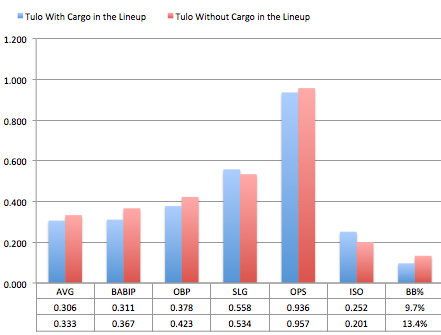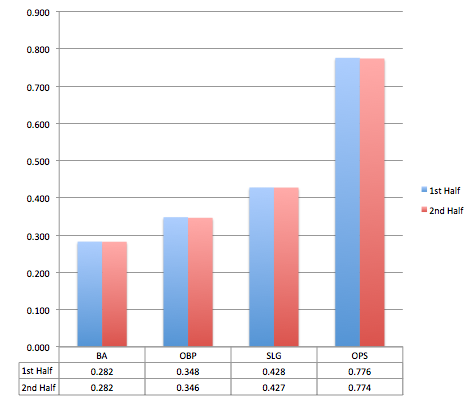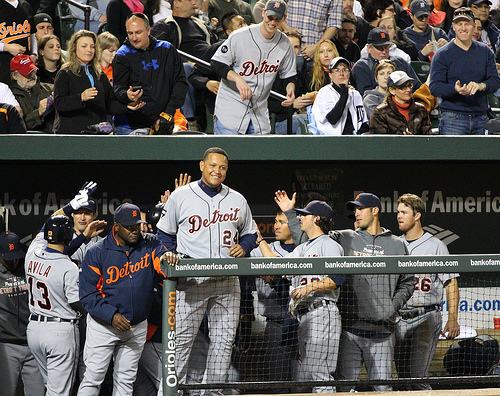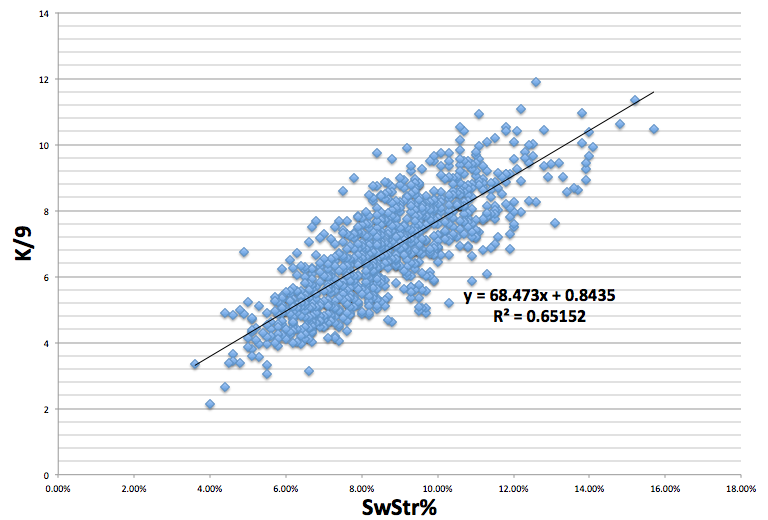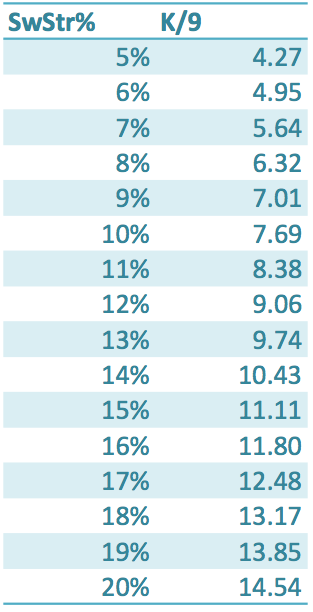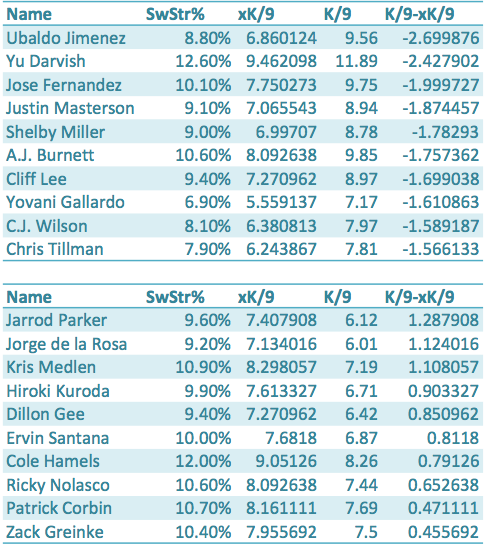Different Aging Curves For Different Strikeout Profiles
What follows will look at aging curves as they relate to players with specific strikeout profiles. Specifically, we will look at how wOBA ages for players that strikeout more than the league-average strikeout rate and less than the league-average strikeout rate.
Through the research that is presented in this post, two points will be proven:
- Players of different strikeout profiles age—their wOBAs change—at different rates.
- The aging curve for players of different strikeout profiles has changed over time.
Before I present the methodology, the research that was conducted, and their conclusions, I want to give a big thank you to Jeff Zimmerman, who has not only done a lot of research around aging curves, but has also helped me throughout this process and pushed me in the right direction several times when I was stuck. Thank you.
Population
In order to give a non insignificant amount of time for a player’s wOBA to stabilize, but not place the playing time threshold for plate appearances so high that we artificially limit the population even more than it naturally is at the ends of the age spectrum, I looked at all player season from 1950 to 2014 where a player had a minimum of 600 plate appearances for the first aging curve in this post. The second aging curve in this post looks at all player seasons from 1990 to 2014 with a minimum of 600 plate appearances.
Now that we have our population, we need to split our population into two groups: players that strikeout more than league average and players that strikeout less than league average.
Because the league average strikeout rate of today is very different than it was 65 years ago, we can’t look at a player’s strikeout rate from 1950 and compare it to the league average strikeout rate of today.
In order to divide the population into two groups, I created a stat that weighs a player’s strikeout rate against the league average strikeout rate for the years that they played. For example, if a player played from 1970 to 1975, their adjusted strikeout rate would reflect how their strikeout rate compares to the league average strikeout rate from 1970 to 1975.
Players were then placed into two buckets based on their adjusted strikeout rate: players that struck out more than league average and players that struck out less than league average.
Methodology
There has been a lot of discussion over the years about the correct methodology to use for aging curves. This conversation has had altruistic intentions in the sense that it’s aim has been to minimize the survivorship bias that is inherent in the process, and, through the progress that has been made over the years, this study uses what the author has found to his knowledge to be the best technique to date. This article by Mitchell Lichtman summarizes a lot of the opinions.
While there is a survivorship bias inherent in any aging curve, the purpose of the different techniques used to create aging curves is to minimize the survivorship bias wherever possible.
What We Don’t Want In an Aging Curve
An aging curve is not the average of all performances by players of specific ages. For example, say you have a group of 30-year-old players that have an average of a .320 wOBA and group of 29-year-old players that have an average of a .300 wOBA.
The point of an aging curve is to see how a player aged, not how they played. The group of 30-year-old players has a high wOBA because they are a talented group of players; they lasted long enough to play until they are 30. As they aged from the previous year, when they were 29 to their current age 30 season, they lost the bottom portion of players from their player pool. These are the players that couldn’t hang on any longer, whether it be because of a decline in defense, offense, or a combination of both. This bottom portion of players lower the wOBA of the current 29-year-old population through their presence and raise the wOBA of the 30-year-old population through their absence.
At the same time, the current 30-year-olds aged from their age-29 season to their age-30 season. Sure, there may be players who had a better age-30 season than age-29 season, but the current group of 30-year-olds, as a whole, still played worse at 30 than they did at 29.
When you look at the average of a particular age group, in this case 30-year-olds, you only see the players that survived, and, because they no longer play, you leave behind the players that are hidden from you sample. The method that follows resolves this issue to an extent.
What We Do Want In an Aging Curve
This study uses the delta method which looks at the differences of player seasons (i.e. a players age 29 wOBA minus their age 28 wOBA) and weighs those differences by the harmonic mean of the plate appearances for each pair seasons in question.
I would explain this further, but Jeff Zimmerman does an excellent job of this in a post on hitter aging curves that he did several years ago. While Jeff Zimmerman looked at RAA, which is a counting state, the methodology is basically the same for our purposes and wOBA, which is a rate stat:
In a nutshell, to do accurate work on this, I needed to go through all the hitters who ever played two consecutive seasons. If a player played back-to-back seasons, the RAA values were compared. The RAA values were adjusted to the harmonic mean of that player’s plate appearances.
Consider this fictional player:
Year1: RAA = 40 in 600 PA age 25
Year2: RAA = 30 in 300 PA age 26
Adjusting to harmonic mean: 2/((1/PA_y1)+(1/PA_y2)) = PA_hm
/((1/600)+(1/300)) = 400
Adjust RAA to PA_hm: (PA_hm/PA_y1)*RAA_y1 = RAA_y1_hm
(400/600)*40 = 26.7 RAA for Year1
(400/300)*30 = 40 RAA for Year2
This player would have gained 13.3 RAR (40 RAA – 26.7 RAA) in 400 PA from ages 25 to 26. From then, I then would add all the changes in RAA and PA together and adjust the values to 600 PA to see how much a player improved as he aged.
Findings
Below is an aging curve by strikeout profile for all player seasons with over 600 plate appearances in a season from 1950 until 2015.
We can see several findings immediately:
- Players do age differently based on their strikeout profile.
- Players that strikeout more than league average peak at 23.
- Players that strikeout less than league average take longer to hit their peak—their age 26 season.
- Players that strikeout more than league average age better than players that strikeout less than league average.
From a historical perspective, this graph is fun to look at, but the way the game was played over half a century ago is eclipsed by societal evolutions that today’s players benefit from.
To give us a more realistic idea of how today’s players age relative to their strikeout rate, I made another graph the at looks at player seasons from 1990 to 2014.
What we find in this graph, which is more current with today’s style of play, is that players still age differently dependent on their strikeout profile, but not in the same way that they did in the previous sample.
Players that strikeout more than league average still peak earlier than players that strike out less than league average, but in this more current population of players, players that strikeout more than league average peak very early—their age 21 season. This information would reciprocate the sentiment that has been conveyed through recent work that suggests that the aging curve has changed to the point that players peak almost as soon as when they enter the league.
The peak age for players that strikeout at below league average rates is still 26, but whereas this group aged more poorly than the strikeout heavy group in our previous population, players that strikeout at below league average rates now age better than their counterparts.
Conclusions
This information can make material differences for our overall expectations and outlooks on players.
Previous knowledge would suggest that players like George Springer and Kris Bryant—players who have exorbitant strikeout rates—are still on the climb as far as their talent goes, but this information shows that these players may already be at/close to their peaks or on the decline as far a their wOBA is concerned.
This information also shows that we should be patient with prospects that have a penchant to put balls is play; while they peak more quickly than they did in the previous population, they take longer to develop than players with more swing and miss in their game, and when they do start to decline, there isn’t much need to worry, because their climb from their peaks will be gradual.
Like many other studies that have looked at new aging curves, this study confirms that players/prospects peak earlier now than at any other point throughout history, but it also shows that a player’s trajectory upward and downward is dependent on characteristics specific to their approaches at the plate.
Devon Jordan is obsessed with statistical analysis, non-fiction literature, and electronic music. If you enjoyed reading him, follow him on Twitter @devonjjordan.



